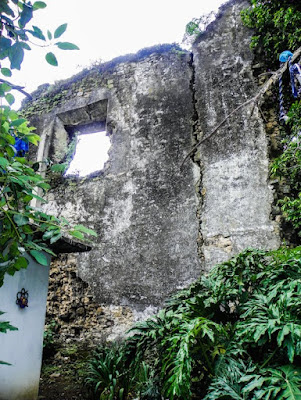However, late in the 1550s, they moved to a more central site and a great monastery slowly rose there; its church of Our Lady of the Nativity destined to become the flagship Dominican priory for the region.
In previous posts we have looked at its architecture and the varied stone crosses of Tepoztlán. Here we review some of the highlights of the early colonial mural program of the convento.
The Murals Although the convento was not completed until the 1580s, as with the other Dominican houses in the region, the walls and ceilings of the Tepoztlan convento were covered with murals in a variety of sizes, styles and colors. Sadly, some of these have deteriorated to the point where few whole passages remain. However, the surviving fragments do give the visitor some insight into the former richness of the mural program here.
More than other Dominican monasteries in Morelos, and perhaps because of its role as the mother house for the region, the mural decoration at Tepoztlan is almost exclusively, even obsessively focused on the symbols, insignia and the glorification of the Order.
Throughout the convento, in the cloister and side rooms, ubiquitous artesonado ceilings incorporate the Dominican symbol of the rosette, contained within the usual hexagonal patterning and rendered in painstaking attention to every unfolding petal.
Everywhere too, the stylized Dominican fleur-de-lis cross appears, accompanied in turn by musical angels, swags, stars, foliage and here, the Dominican dogs, flaming torches upheld in their teeth.
Throughout the convento, in the cloister and side rooms, ubiquitous artesonado ceilings incorporate the Dominican symbol of the rosette, contained within the usual hexagonal patterning and rendered in painstaking attention to every unfolding petal.
Everywhere too, the stylized Dominican fleur-de-lis cross appears, accompanied in turn by musical angels, swags, stars, foliage and here, the Dominican dogs, flaming torches upheld in their teeth.
The Sala de Profundis
The sole surviving narrative murals at Tepoztlán are found in the former friars' chapel. Over the doorway, flanked by angels, two Dominican friars, presumably Fray Domingo de la Anunciación (Thomas Aquinas?) and St. Dominic himself, uphold the church. God the Father looks down in approval from above.
The sole surviving narrative murals at Tepoztlán are found in the former friars' chapel. Over the doorway, flanked by angels, two Dominican friars, presumably Fray Domingo de la Anunciación (Thomas Aquinas?) and St. Dominic himself, uphold the church. God the Father looks down in approval from above.
Along the walls, rows of friars clutch crosses and books, symbols of faith and martyrdom, oddly accompanied by crossed bones. The room is ringed by another undulating frieze, this time with entwined, serpentine fish, dolphins and birds—possibly ibis?
Although any original narrative mural scenes have disappeared from the walks, a striking frieze or dado wreathes its way along the walls at shoulder height, Crowned heads of kings emerge amid the foliage incorporating medallions with various insignia, including again the Dominican cross.
Apart from the dado, no other original murals remains in the cloister aside from a Calvary scene in one corner niche which depicts three wooden crosses rising above a rock-strewn sepulcher while stylized trees rise behind the cairn and an empty tomb stands in front—signifying Crucifixion and Resurrection.
text © 2019 Richard D. Perry.
images by the author, Niccolò Brooker, Robert Jackson and ELTB











No comments:
Post a Comment